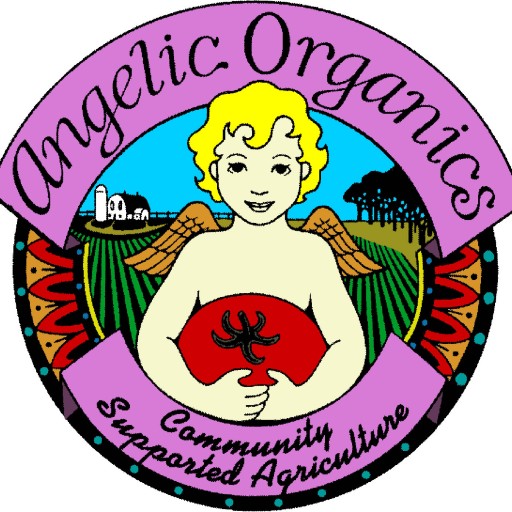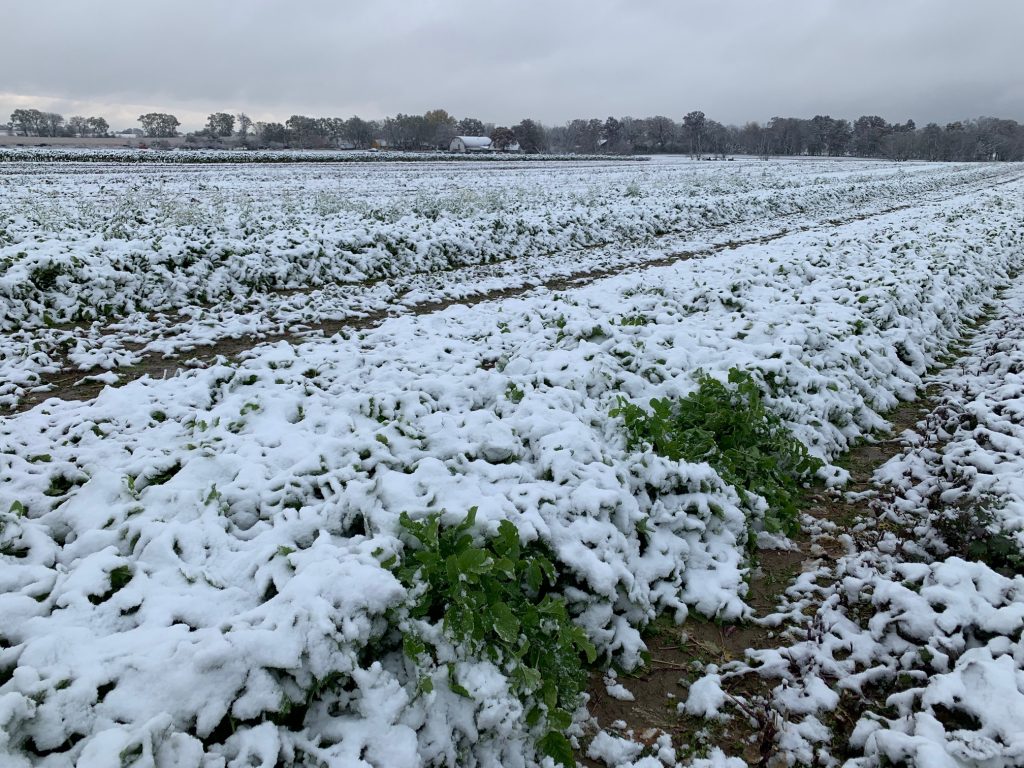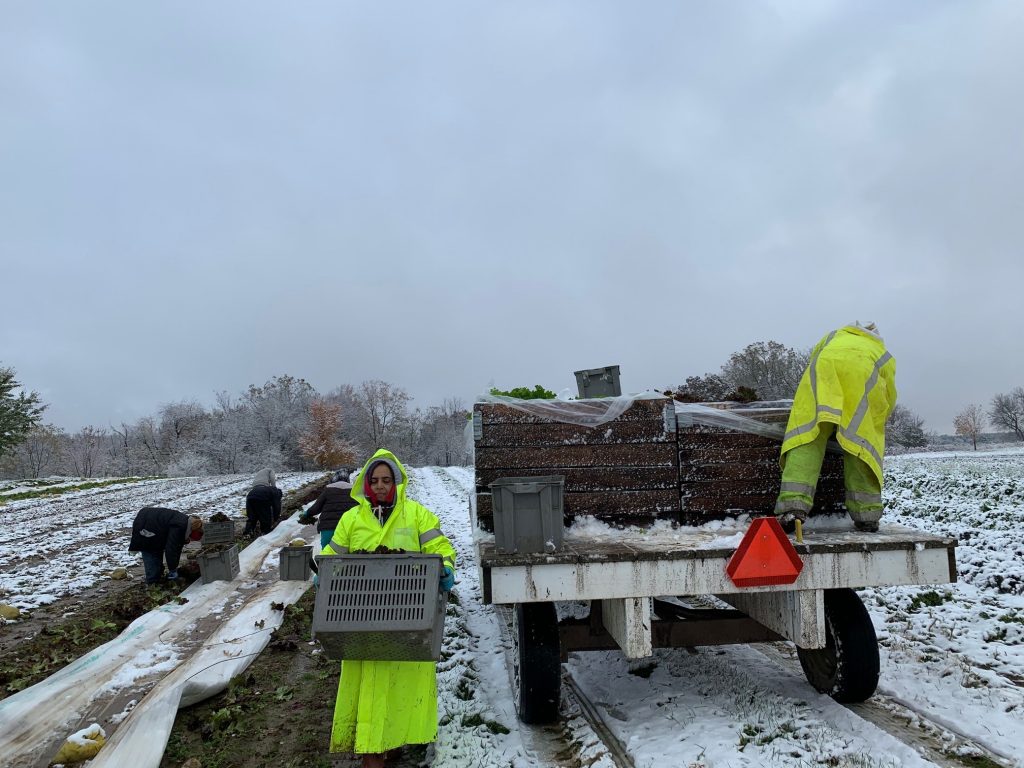Farmer John Writes: I Looked into the Air
Week 18, November 5th – 9th, 2019
I wrote last week that rain came down like rivers on Saturday, transforming our fields from muddy to soupy. Even though we have had record rainfall throughout the year, I believe this past week is the wettest our fields have been all year.
The weather forecast for this past week indicated some drying weather, offering perhaps another opportunity to harvest our potatoes. However, the weather was not drying–it was wetting–further diminishing our chances to harvest about 20,000 pounds of potatoes.
Several people have said, “do it by hand–fork them out.” Not physically, humanly possible, not out of this mud. I don’t believe a person could even walk in this mud, let alone extract potatoes from it. Do drones harvest potatoes?
On Monday morning, I could see something ominous in the air. It was a sort of invisible color, if there is such a thing. I kept looking at the air–perhaps it is more accurate to say I was looking into the air–and I saw trouble coming.
Trouble came faster than I imagined–snow on Monday night. We had large quantities of crops still in the fields. Snow was not going to kill these crops, but it certainly would slow down the harvest. (A layer of snow on crops can actually protect them from hard frosts, acting as a blanket of insulation.)
That foreboding air on Monday morning was not only a harbinger of snow; a killing frost was also on its way. (Killing frost is a bit of a misnomer; I suppose hard frost is more accurate. Kale, cabbage, and leeks will survive hard frosts, unless the frost is too hard, say down to 10 or 15 degrees.)
We prioritized what to harvest: the lettuce under protective row covers would never survive a hard frost; mizuna might survive, might not; daikon greens will not, nor will the actual daikon radishes.
More snow fell. The challenge was not only that a hard frost was coming, it was getting crops that were heavy with snow out of the fields.
“Hey, you guys, shake the snow off the daikon leaves before you bunch them. You’re all wearing rubber gloves, right? You dressed warm? Everyone dressed warm?”
The crew did great work in the cold, damp weather–harvested the daikon greens, the daikon radishes, beautiful lettuce, cabbage and Brussels sprouts tops.
Still to harvest– frost hardy leeks, kale, and more Brussels sprouts tops.
Imagine within 5 days’ time: epic rains, heavy snow, hard frost.
About the Crop Report in Last Week’s Farm News
In Farm News, Week 17, I offered a report on the fall crops. (If you didn’t see it, I suggest you check it out.) I wrote that the losses of some of our fall crops, notably the potatoes, broccoli, Brussels sprouts and cabbage, constituted about 1/8 of what we planted this year. This was about the equivalent of 5 fields of losses (1 field is 500 ft x 54 ft or about 2/3 of an acre).
A rough estimate of what it costs to grow a field of anything at Angelic Organics, including all associated costs, such as seed, soil fertility, labor, utilities, delivery, supplies, machinery and building upkeep, insurance, marketing, etc. is about $25,000.
To offer more detail on the losses, none of the Brussels sprouts formed properly; they were very small and many of them turned black. That’s about 6000 stalks that didn’t yield sprouts.
We lost most of the cabbage field; there were 9000 cabbage plants and we harvested under 1000, and most of those we harvested were very small. We lost about 9,000 out of 18,000 broccoli plants in 2 fields. We are likely to lose 20,000 or 25,000 pounds of potatoes, about 2/12 fields.
Now, please don’t think Angelic Organics is a money machine because of the rough number of $25,000 per field. To the contrary, these numbers keep the farm from being a money machine. $25,000 per field is the cost to grow the crops. The money we make, if any, comes after these expenses are paid. (For comparison, row crops, such as corn and beans, might cost $500 per equivalent field.)
To be more comprehensive about crop losses this year, I will offer that, from the early season crops and the mid-season crops, there was probably the equivalent of at least another 5 whole fields lost due to weather. We lost about 2/3 of 2 zucchini fields; 9/10 of the pepper field; 1/3 of the eggplant field; a lot of early choi and Chinese cabbage; almost all of our celery, all of our celeriac; bed after bed of spinach, arugula, mizuna, baby choi, and baby lettuce to irrepressible weeds–probably the equivalent of 1 and 2/3 fields. This is roughly equivalent to 5 fields lost earlier in the season in addition to the fall crop losses.
To summarize, this year we lost the production from at least the equivalent of 10 fields out of 40 fields. I suspect the losses might be as much as 1/3, when I take into account crops we were going to plant but could not, due to weather. (Some of those crops were transplants which we could not get into the ground.)
These are staggering losses. (Don’t do simple math to arrive at a $250,000 loss from 10 fields. Accounting isn’t really that simple, but you still get a picture of the severe impact of the losses.)
Also, imagine the extra labor, seed and fuel to re-plant, re-seed, to battle weeds often 10 times worse than I have seen here in the last 25 years. These efforts represented tens and tens of thousands of dollars of unanticipated expenses in order to do everything possible to provide you with food.
Once we hit our stride in the mid 1990’s, we increased our yields pretty much every year for 20 years. It was quite an astonishing accomplishment, knowing what I knew since childhood about farming–that yields tend to ebb and flow, not just go up year after year after year.
Three years ago, we had our first serious yield decline since the 90’s; last year, our second yield decline; this year, our 3rd yield decline, all due to the excessive rains. Weather trends are not a straight line; they tend to be erratic, even if going in a particular direction–more like a chart tracking the value of a corporation’s stocks. Will there be excessive rains next year? I don’t know.
If someone had accurately described this season’s weather to me before the season started and I knew that prediction to be true, I would have said, “no need to plant anything, because there will be nothing to harvest.” There are plenty of shareholders who complain vigorously about an item missing from their customized box that someone on the pack line unfortunately neglected to add. The miracle this season is that there has been anything in the boxes–anything.
Thank you to those of you who recognize the challenges of this season and who appreciate the bounty that has come forth.
Your Share
Let the farm office know anything you’d like to share about this week’s box at email hidden; JavaScript is required. Please note the week and day of delivery, your site, when you picked up your box, and any comments about your box. If your box is missing an item, let us know at email hidden; JavaScript is required and we’ll make it right.
Emails
Make sure to add both email hidden; JavaScript is required and email hidden; JavaScript is required to your email address book to make sure that you receive all pertinent emails.
Please Fold Your Boxes Properly and Return Them
The farm re-uses the vegetable boxes. Flaps are easily torn when the boxes are dismantled improperly, and then the box bottom might later burst open with fresh, organic local produce heading towards the floor. Please carefully flatten your box and return it to your delivery site. If you receive home delivery, place your flattened, empty box it in the location where your box is delivered.
Thank You
Thank you for being with us for a dramatic farming adventure this season.
Warmly,
Farmer John







My understanding of a CSA is that we share the bounty and the risks. Angelic Organics survives through the hard work of Farmer John and his crew with the help of our subscriptions. How much more frustrating for those working the field to see their hard work come to naught than those of us who are missing a few things from our boxes! So thank you all for your work and I’ll be around for years to come to enjoy the bountiful delicious produce in the good years, and to be creative with the produce in the hard years.
Here, Here, Sydney! We’ve been members for at least 15 years now and from our perspective, we‘ve yet to have a disappointing season. We feel we always get a greater value for our dollar than we would at the grocery store. That would be true even if some weeks our box arrived nearly empty. We joined a CSA not just for the quality of the food we get, but for the knowledge it is grown ethically, with environmental stewardship, and love. With the help of Angelic Organics, we were able to teach our children about good nutrition, where food really comes from, the true price of the food on our plates, and the impact the food we eat and the choices we make have on our environment. Our annual share fee is nominal for all Farmer John, Haidy, and the rest of the awesome crew provides to our families each and every week!
Feeling thankful for the vegetables you HAVE been able to harvest. Even this year Angelic Organics has added to the diversity and nutritional value of my family’s dinner table. No complaints here. And reading about the vagaries of farming helps me feel connected to the farm (and better able to understand occurrence of unusual and enormous weeds in my yard/flower garden this year).
I read in your newsletter that you lost some crops which were “transplants” that you could not get into the ground. Would you consider offering the excess transplants for sale to your customers through the Harvie platform? I usually end up buying started tomatoes, peppers, etc for my home gard e n but I cannot find organic ones.
Keith and I have slowly learned how to not waste food over the last few years. Today butternut squash soup is simmering gently. It will go down to 17 tonight but our tummies will be warm and full. As shareholders we ride the ups and downs with you, in a more tangible way that the wall St. shareholders do their stocks. We have already signed up for next year; we’re coming along with you for the next adventure.
I am also volunteering for citizens Climate Lobby, so that emissions lower, and the weather patterns that climate scientists predict will gradually abate by the end of the century. Agriculture is exempt from the carbon fee, because farms only emit 1% of U.S.emissions, and have extra challenges to face , what with all the extremes.It’s long term collective strategy for a revenue neutral carbon fee and dividend, and a within-the-week household cooking strategy for tasty nutrition.
Thank you to everyone at Angelic Organics for all your efforts, hard work, and passion this season and in seasons past. I am grateful to you for what you do and truly appreciate all that has gone in to getting healthy vegetables to my family and many others.
I am hoping that the winter season brings healing to the fields and most importantly to Haidy.
The above writers have spoken my heart – I am honored to be a part of CSA and thankful for the bounty we have received from Farmer John, Haidy, and the dedicated employees at Angelic. We won’t be returning next year – but only because we have moved to another state. Because of our experience with Angelic, we will always support CSA no matter where we live. Thanks for the great veggie stash, Farmer John!